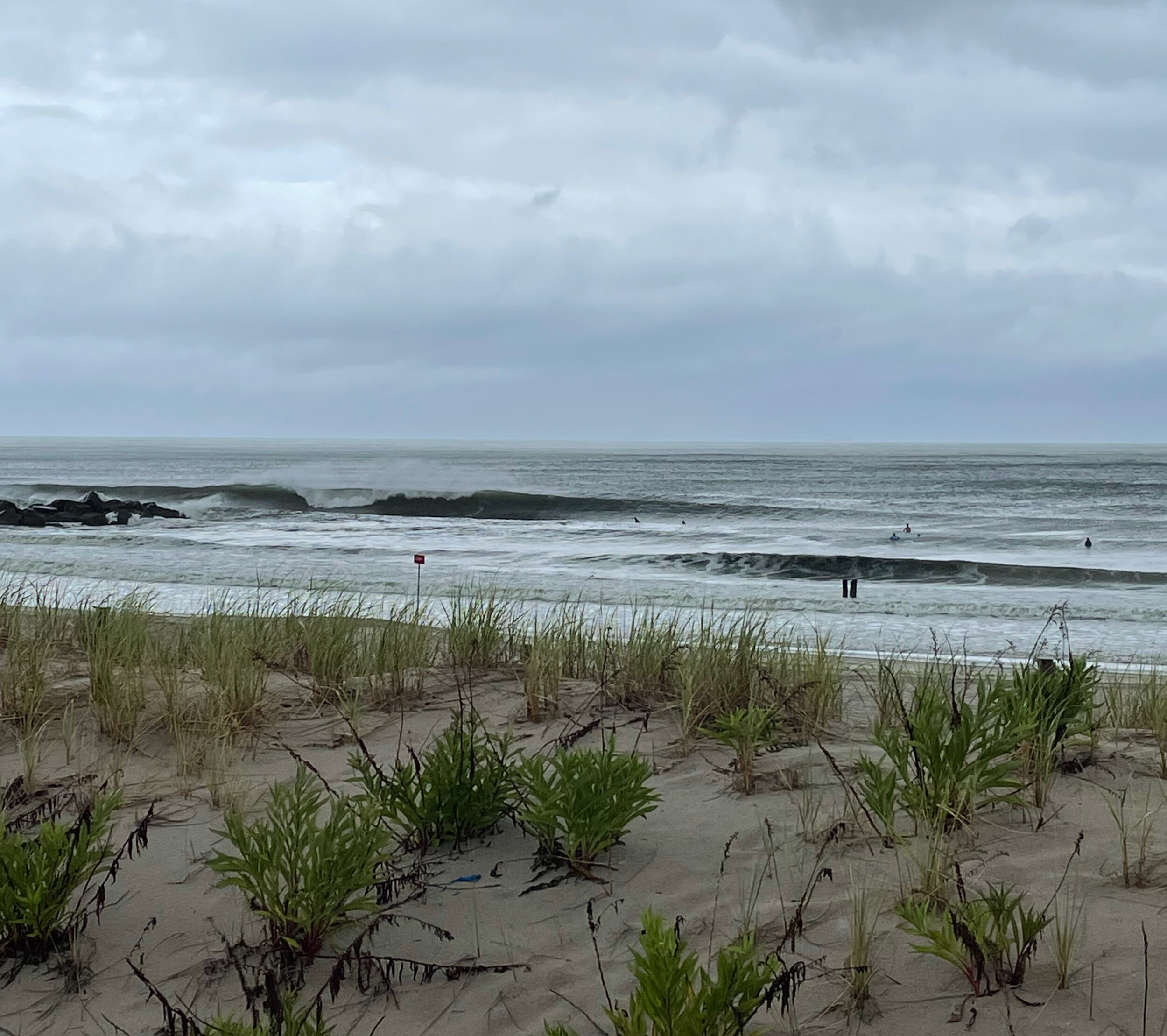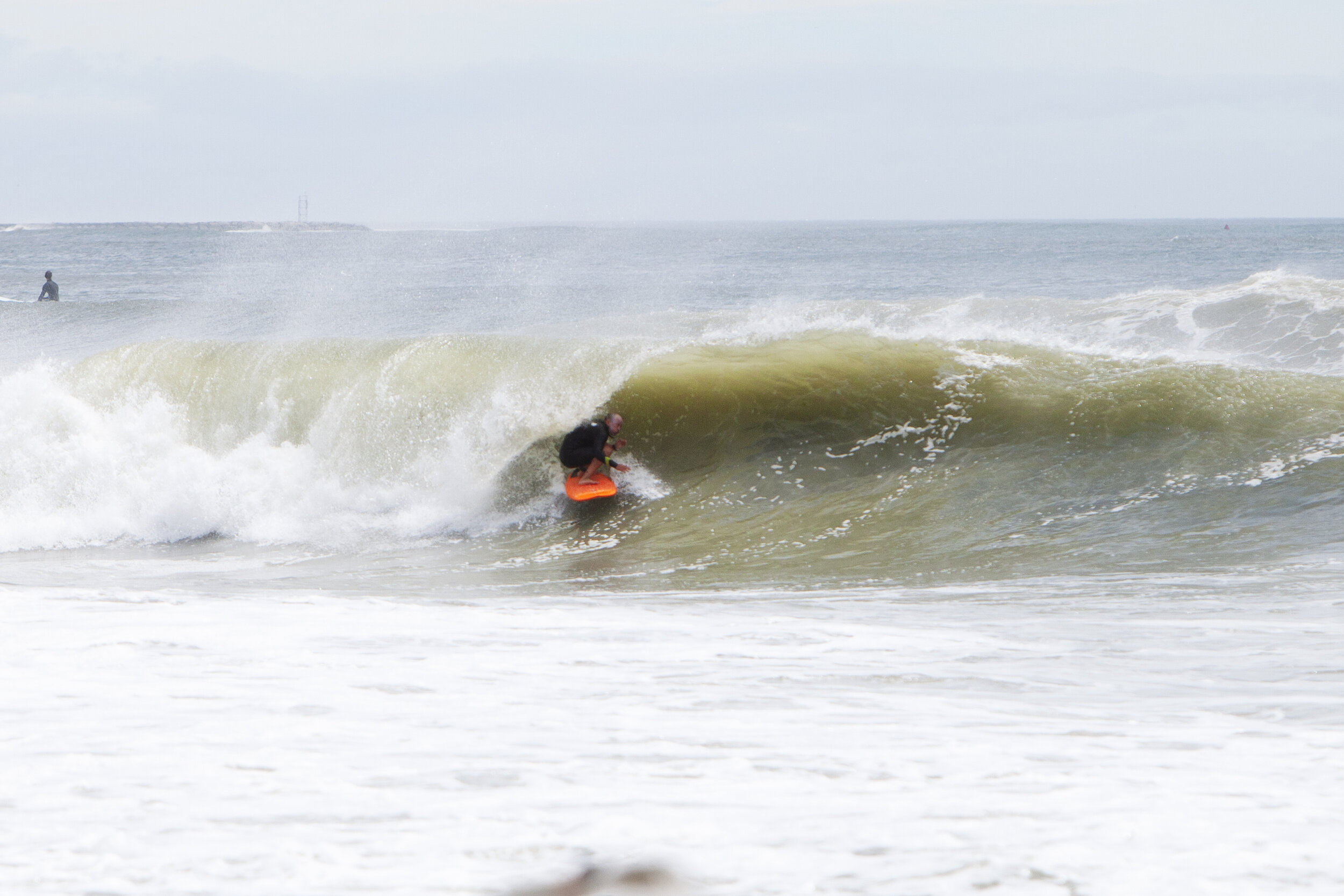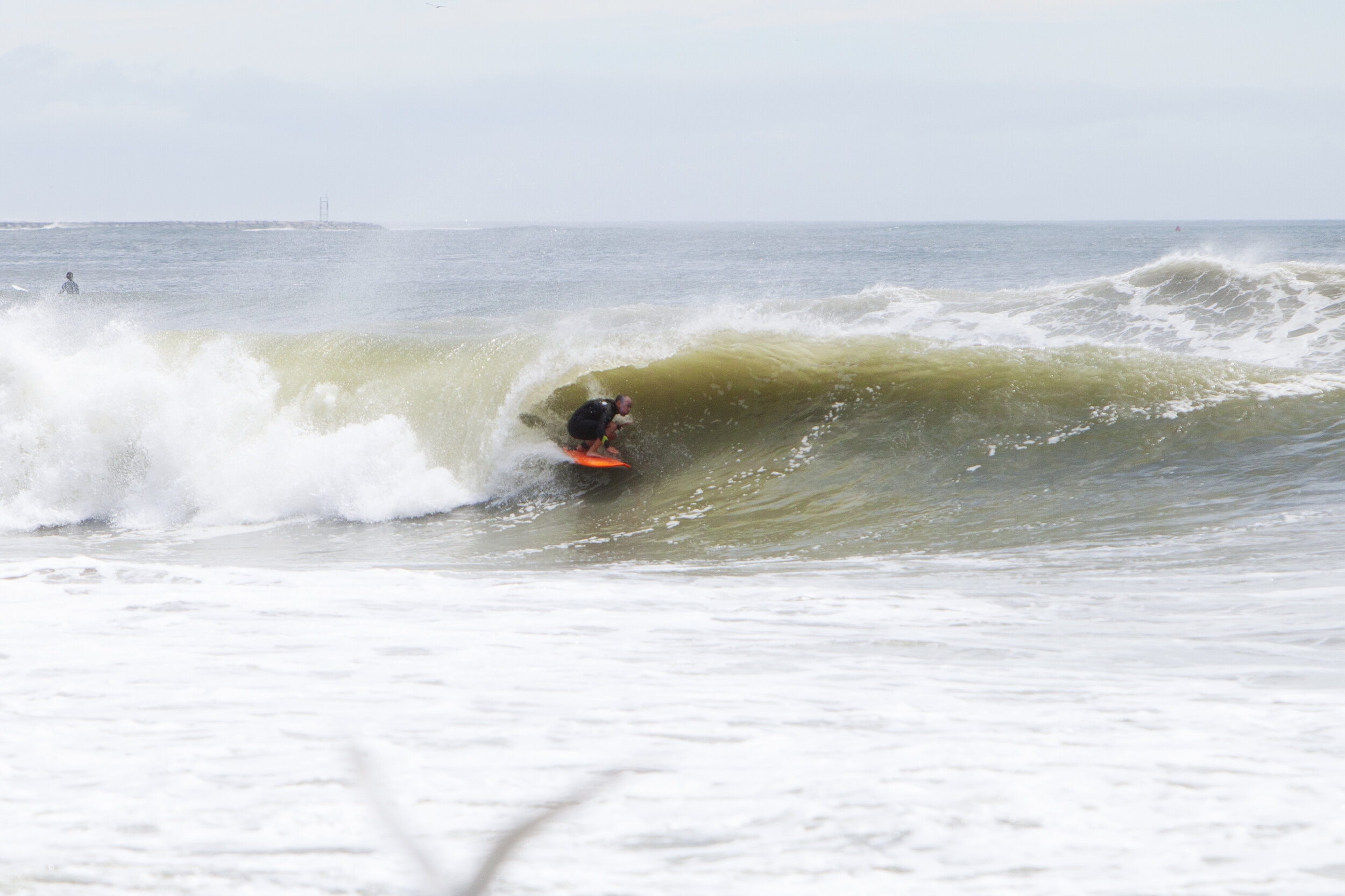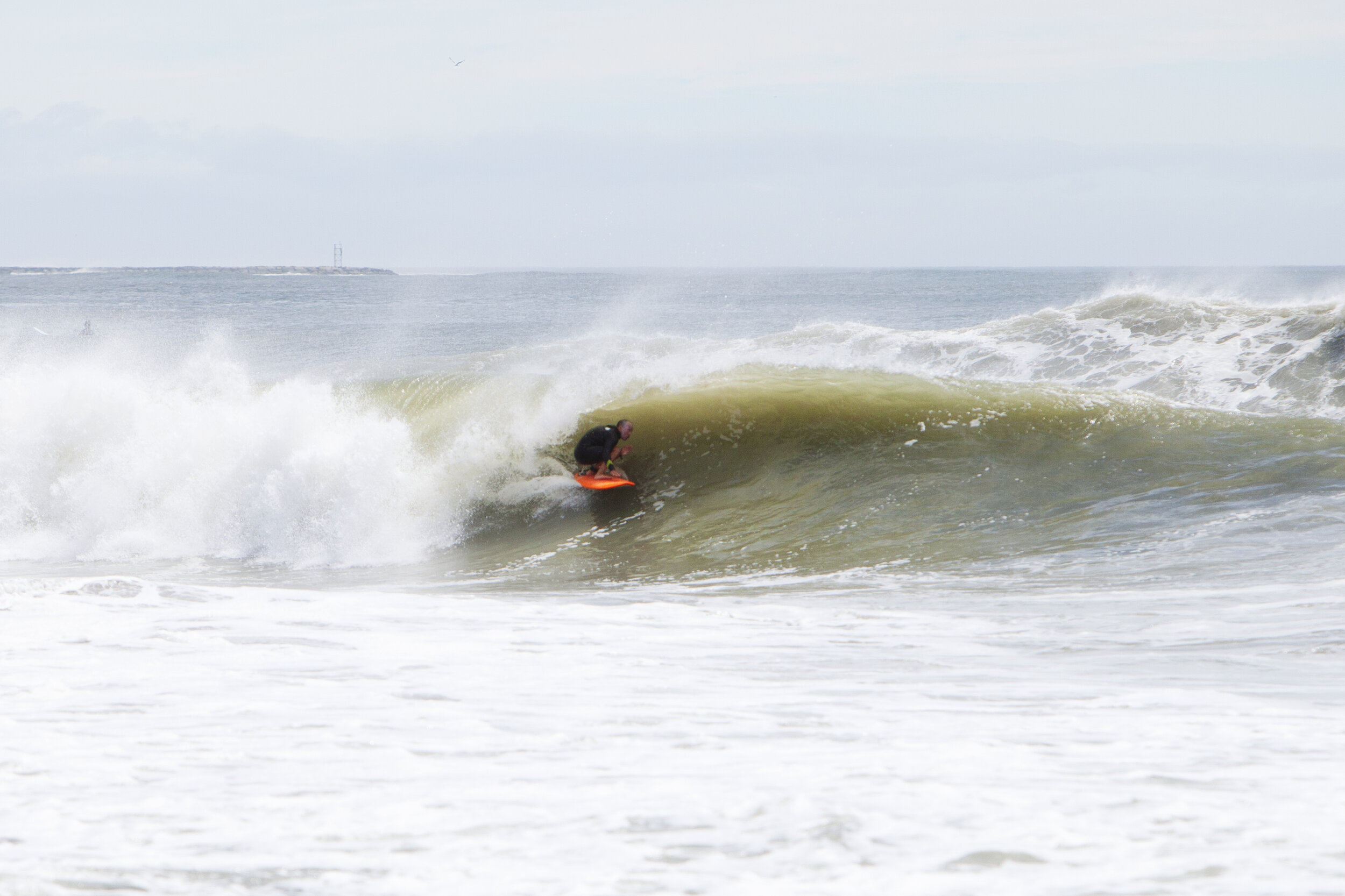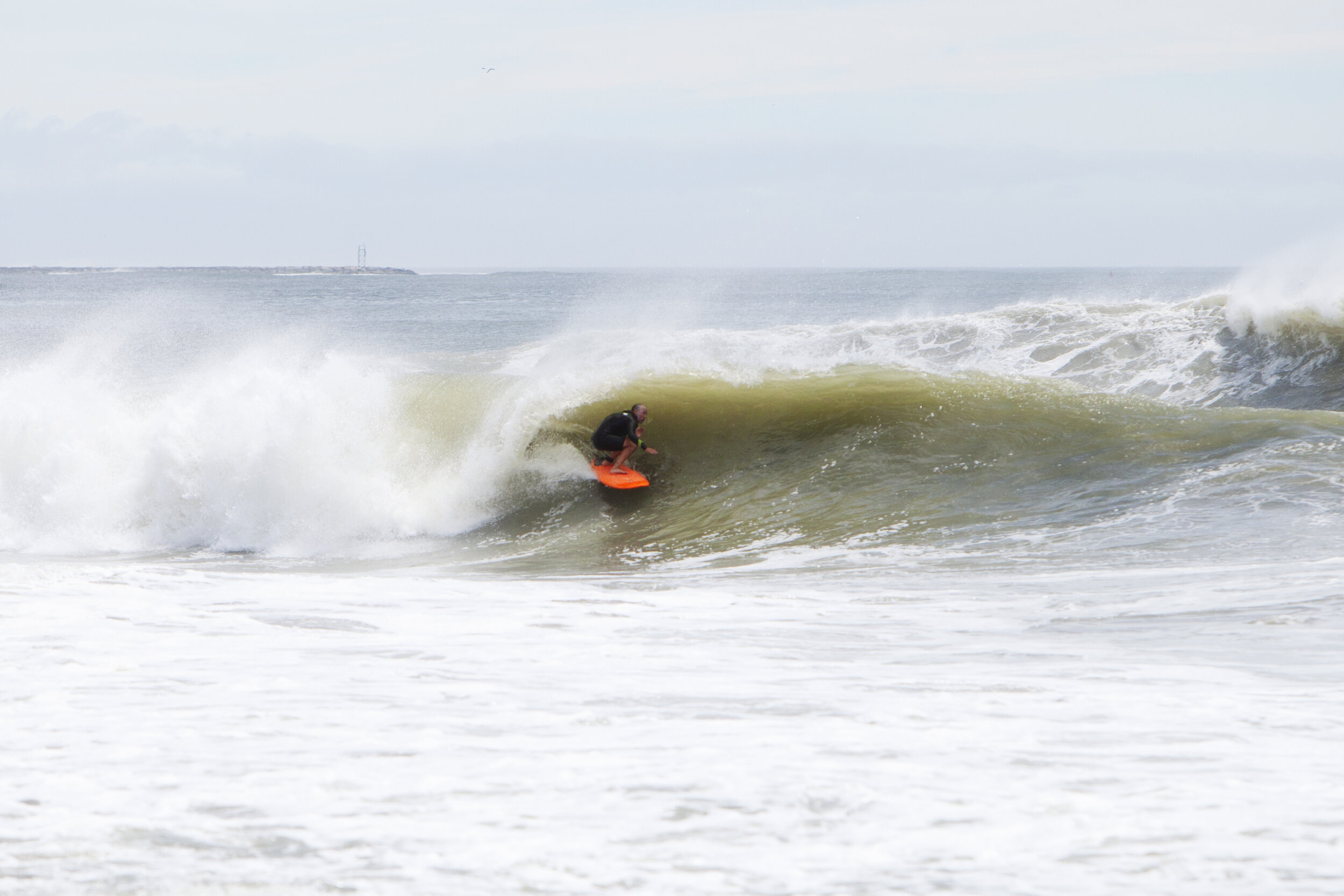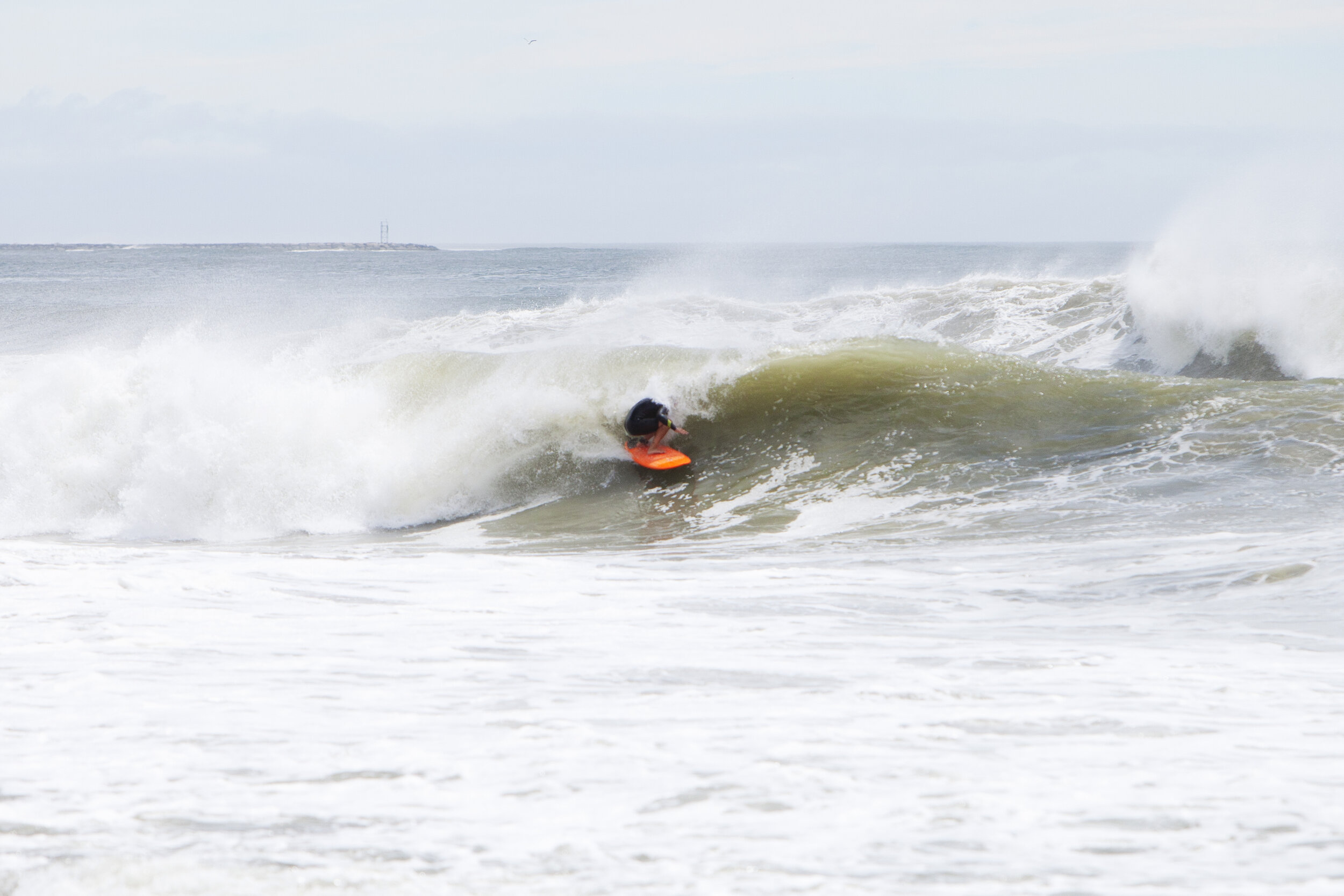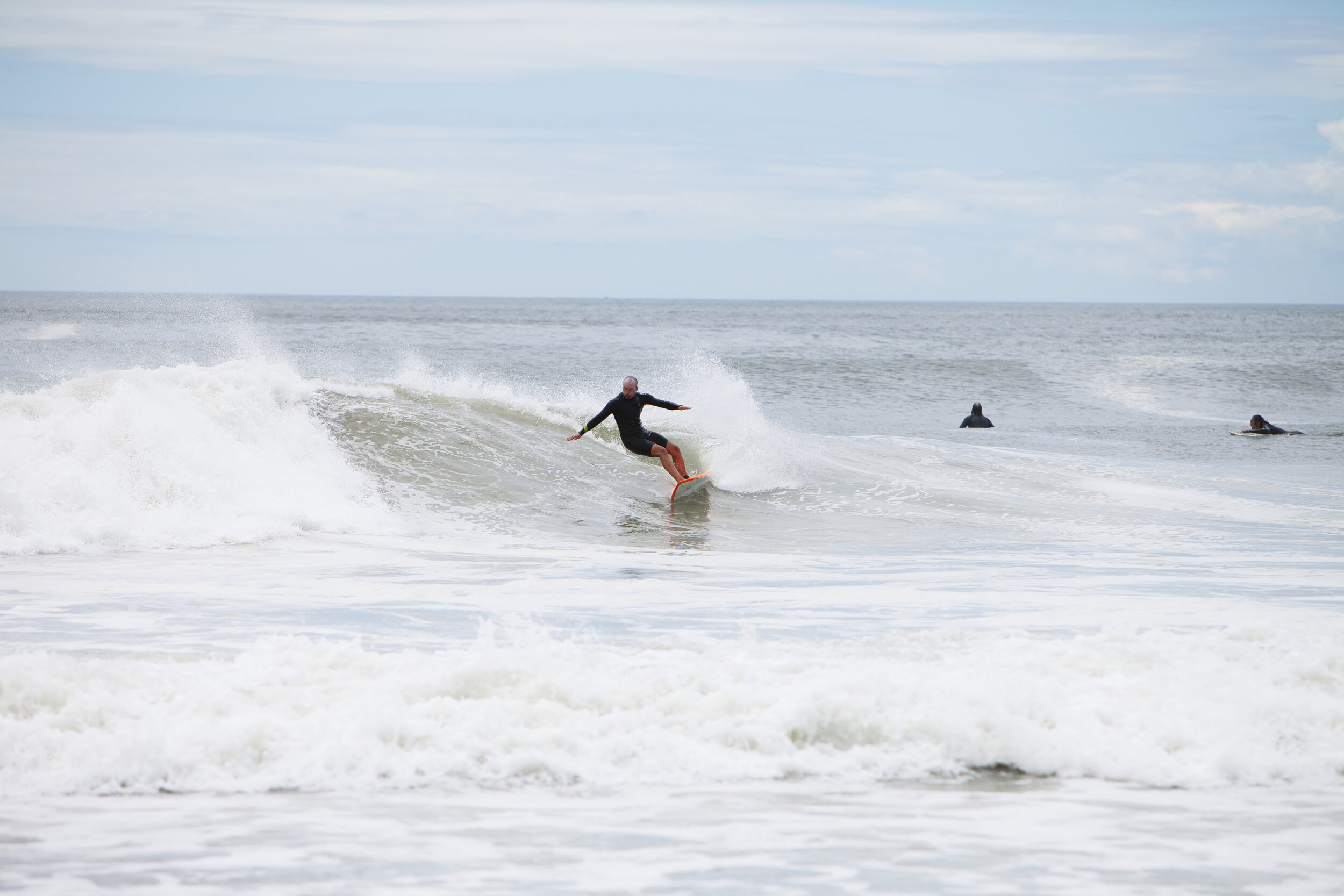For me Tropical Depression Elsa was one big “I told you so” swell event. Now I couldn’t have predicted that we’d get any surf of significant size in July just going off of historical data. Historically July is one of the flattest, dullest months for surf on the East Coast, and in NY in particular. But the Atlantic, despite what some surf forecasting websites may say, has been quite active over the past few weeks. Where do I get my information? I just look at pulled back storm and wind radars on Windfinder. While everyone is relying on Surfline’s predicted buoy readings I’m looking at the actual predicted storms — their size, shape, and mutations as they move over waters and lands. Surfline has access to this same data, but for some reason they’re really bad at interpreting it for our area (or for most areas). Perhaps some of the only people who knew it would be as big as it turned out to be are those that subscribe to my weekly newsletters on Subkit. As early as July 2nd I was writing to them about Elsa’s predicted track. Even at that time she looked large and in charge.
Windfinder screen capture of Elsa’s predicted track July 2, 2021.
Now it’s not writ in stone that a prediction a week out will hold, which is why I check the models every day, a few times a day. Elsa’s track pretty much stayed true to all of the model predictions: she came across the Caribbean, devastating Barbados to a certain extent, went into the Gulf of Mexico and up into the Southern United States, and then came back off the coast of the Carolinas, into the Atlantic, headed north for us, clobbering Long Island and Rhode Island, before heading back out to sea. And she wasn’t just one of those here today gone tomorrow events. She had a long tail of low pressure coming up behind her, which made for surfable waves the day after. Saturday’s waves weren’t great because the swell direction and tides and lifeguard laws were not in coordination with one another, but it was far from flat. And the big day, Friday, was, as I had predicted, well overhead during the peak of the swell — not the 3-4 feet that Surfline had predicted. I literally had a zillion text messages from beginners and intermediates (all of whom I have supposedly trained to read surf forecasts) requesting a session or to be on the list for Friday. The first thought I had was, “Are you even looking at Windfinder’s models?! That storm is HUGE!” In no world does a mass of energy that big create 3-4 foot surf, unless you’re using the Hawaiian scale, which is a macho way of down playing the size. It was 3-4 foot Hawaiian, which means head high to double overhead.
I am 5’6”. This wave is twice as tall as me. 2 x 5.5 does not equal 4. But a Hawaiian would still say this wave is 3-4ft, even though it’s clearly about 8ft. Pic: Franco Rinaldi.
Elsa’s predicted track on July 7th. In no world does that much energy off of our coast equate to waist to chest high surf. If you see a blob that big ever again, expect overhead surf.
It’s all about seeing those low pressures — the green, yellow, and red blobs — as movement over the water that creates waves for us to surf. The bigger the blob, and the more yellow, orange, and red it is, the bigger the waves it will produce. Even a big green blob will produce surfable waves. Why? Because it’s some movement over the water rather than none. Little to no movement is indicated by the purple and blue colors on Windfinder. I am not even a meteorologist by training. I just look at the size of the blob and its color and of course its track and guess whether it will produce small, medium, or big waves. Again, the bigger the blob, the bigger the waves. Elsa was always a healthy size. Not a hurricane, but close. And so I expected larger than average surf. I also expected to see people in the water who were going to inevitably say to me, “I didn’t expect it would be this big,” to which I reply, “Funny, I did.” This happens almost every significant swell that we have. The only time it doesn’t happen is when Surfline actually interprets the forecast right, which is rare. The data is out there for free for you to be able to really guess conditions. And if you are still struggling you can just subscribe to my weekly newsletter!
I also geek out on local weather. To be honest I was scared for a second that Elsa would nail us and I’d have to tape my windows and drive my cars to higher ground. But when I looked closer Rockaway was only set to get some outer rim rain action from Elsa while Long Island received the more gale force winds and rains. This is because of the way the storm tracked out to sea — Long Island sticks further out than Rockaway does, so we were spared some massive damage.
I wasn’t in a hurry to get to the beach on Friday morning for three main reasons: 1. I hate surfing in the rain. Some people like it. I don’t. To each their own. Rain looked like it was going to die at around 930/945a. 2. It was high tide at 730a. Sometimes we have good high tide sand bars. Not right now. 3. The swell looked to peak at 12p. I like to surf as long as possible during a swell event, and don’t want to waste energy sitting in the water waiting for the swell to actually arrive. Instead of frothing out, I wrote a blog post (the one on “Fridge Tetris” below), prepared my quiver, had a really long, sweaty, and productive yoga session, showered, and watched a bit of the men’s semi finals at Wimbledon. It was still raining at 930a, but since it always takes me a bit of time to get ready and check the surf, I decided to leave then. When I had arrived at the beach at 940a it was clearly pumping.
940a, Friday, July 9th. Pic: Dion Mattison
Ben Lai, an intermediate surfer, hit me up on the fly for a session. I have been working to help Ben with confidence and strategy in larger surf. He arrived at the same time as I did and as soon as I saw the set above I told him to suit up as fast as possible. The three main boards I had intended to ride for this swell were my 6’1” and 5’6” double wing swallows and my 5’3” rounded pin with a wing, all shaped by Jose Barahona. With sets already in the overhead range I opted for the 6’1” for the first paddle out. More foam is always better than not enough foam in general, but especially when the surf is pumping. It was still lightly raining so I left all the camera gear in the van, thinking I’d grab it as soon as the weather cleared up. The wind was howling offshore I’d say at about 15-20 mph, with a few stronger gusts. I oscillated for a moment on what suit to wear, and picked the 3/2 fullsuit despite a strong hunch that it was already too warm for it.
We started at the first jetty. The tide was still pretty fat, the wind was howling offshore, it was already a bit crowded and I was already overheating in the 3/2. After three failed attempts to get into not very good waves I realized that I didn’t have the patience for that spot so we paddled down to the next jetty which was empty and equally bombing. After three fun rides the rain had completely cleared away and by that time I was pressure cooking inside my suit. The swell was really starting to pulse, but I realized that I had all day, so I went in, changed into my 2mm spring suit, and brought the 5’6”, my camera gear, umbrella, and a container of water to the beach.
I have been having issues with the Solo Shot. I thought I had them cleared up the night previous, but I hadn’t tested it out again. Here was my chance to get epic solo shot footage in pumping surf. I put the up the umbrella and tried to calibrate the damn thing, but to no luck. I was just burning time only to have camera focus on an area far from where I set up the tag. It simply wasn’t going to track, so I’d have to surf perfect waves with Ben alone and get no footage. I am fine with that, but it’s particularly getting footage in this kind of surf that has been eluding me! After 2-3 tries to get the thing to track, I gave up, put the leash on my 5’6”, which I had set up as a standard thruster with medium sized fins, and paddled back out through the high tide sea lettuce swamp. This was an incredibly fun session. Big, long, open walls to carve the board around on — arcs in the lip, cut backs, and end section bashes. I remember my first wave and first turn in that session thinking about how I never get waves to draw these kinds of longer, rounder lines. These were pro surfer surf video waves.
I tried to bring Ben into my rhythm but it’s always hard for newer surfers to understand how active you have to be in beach break surf of this size. There is a lot of water moving and you have to move to be in position. Not only that but when the wind is that hard offshore you have to sit in a position where you’re able to take off under the lip. As I told Ben in the water, “There’s no easy glide in out here. You’re not getting in out the back, and there’s no time to test whether you have it or not. If you’re not under the lip, it simply will not let you in.” This can be a scary proposition but on the other side of the coin the lip stays up and the wave stays open for longer than one thinks due to the same wind. So these are the kinds of conditions in which it is in fact easier to take off under the lip. Ben did get a few waves, but never moved aggressively or sufficiently enough to find himself on the really good ones. I saw him paddling for little ones he was never going to catch and going for closeouts. This is in fact how many people navigate large beach break when it’s bigger. For the most part when I see them surf out there comporting themselves in this way I think to myself, “You don’t really even want to be out here.” I do, however, understand that like Ben, these people do want to be out there, and want to be on the best waves, but whether consciously or unconsciously, they get overwhelmed by the size and energy in the ocean, and spend more time surviving the sets and scratching for scraps, rather than working on positioning to be in the spot to score a gem.
In larger surf with hard offshore winds you have to take off under the lip. If you hover on top of it you’ll be blown back up the face. Pic: Franco Rinaldi
By 1045a the surf had grown another few feet and even my medium sized fins were feeling a little small. The tide really started to pull out and a rip started to form off of the jetty. All signs pointed to the fact that it was time for a bigger board. I went back in, chugged a bunch of water, fielded a few texts, and put the leash back on my 6’1” which I was riding as a 2 + 1. I used the “S Doubles” by True Ames. Just as I was heading back out Erin Yamagata showed up with her camera. Franco Rinaldi also made an appearance at the umbrella. He was a bit anxious about the surf so I said, “Take some pics with my Sony.” And thus all the footage I have of the day was taken during the midday surf on the orange 6’1”. Franco stayed at the umbrella and took shots from front on and Erin moved down the beach to shoot into the lefts. By this time there were a handful of other surfers in the water, but by the looks of their positioning and luck getting into waves they were all wracked by anxiety and beset by poor equipment choices — all of their boards were too small. All except one guy who was sending it on a Canyon fish, but who had the most unfortunate two stage pop up that would cause him to wipe out on particularly steep drops. This is why everyone should eliminate a two stage pop up as early on in their practice as possible. There is even hope for this guy, but he’d have to work on it on a longboard in small surf. As it is, he takes himself out of the game with a labored pop up in fast, tubing surf. With the right equipment and a one stage pop up these waves felt like a playground to me. This was the most pumping surf I have ever seen in July. It’s just so fun to take off on waves that have some juice and so much space for turns and tubes.
Sequence of my first wave second session before Erin had walked down the beach. Pic: Erin Yamagata
None of the tubes I got were the super deep kind where my board and body are so far back I didn’t think I was going to make it. Those kinds of tubes must have been on offer not only where I was surfing, but also at other jetties and other breaks in NY and NJ, but I couldn’t find them this swell. I think on one or two occasions I was just a touch too far inside on waves that would have offered those tubes to me. Now looking back on it, I should have chucked myself into one of them, which I thought was a closeout. That’s been my achilles heel for quite some time — not going on waves that I think are closeouts but which turn out to be the exact mega tubes I desire. Nevertheless I did manage to pull under the hood and get some visions both during the session when the cameras were on me, and in the subsequent surfs when they were not. Erin was only able to shoot for an hour. She had to run back to work. Franco also shot for an hour, and then he paddled out. He said watching the waves through the lens chilled him and gave him a sense of which ones to go for. It always does that for me too! That’s a great example of why people who feel nerves in the face of these kinds of waves are better off taking breaks and watching rather than being out there lost to sea unable to get in the game. After midday the swell started slowing down. I was able to ride the 5’6” and the 5’3” and get tubes and turns on the both of them. By 330p the wind had come onshore lightly out of the SW, but the waves still looked so good. I had had my fill however, and felt satisfied enough to leave the beach. Below is a gallery of the swell by Erin, Franco, Juan (who showed up at 1045), and me.
Tube pics by Erin Yamagata.
Image by Franco Rinaldi of one of the same tubes from a different angle.
Nothing like a cutback after exiting a tube. Pic: Erin Yamagata
Empty gem off the second jetty. You need to sit deep and underneath it if you’re going to get into one of these suckers. Pic: Dion Mattison
Juan setting up the inside tube on a frothy one. Juan isn’t scared to get a set on the head and that’s why he’s always on those critical inside waves no one else can seem to find. Pic: Franco Rinaldi
Juan and Franco head out. Pic: Dion Mattison
Izzy Cohan and Allie Marsiello all smiles on a day of pumping waves. Pic: Juan Heredia
In surfing, less movement is more efficient. Me standing tall looking at it. Pic: Franco Rinaldi






